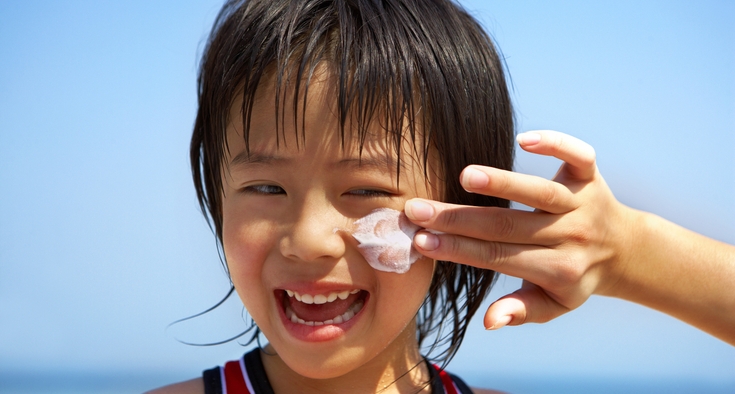By Regan M. White and Greg Sullivan, Novant Health Healthy Headlines
To find and book a physician click here.

Tank tops, shorts, sundresses and bikinis – however you choose to brave summer’s blistering temps, make sure you play it safe with all that time spent outside in the sun.
Dr. Phillip Khan of Novant Health Coastal Plastic Surgery provided some sun-safety tips to follow this season.
1. What you need to know about SPF
Sunscreen is important because it provides a barrier of protection from the damages that can come from ultraviolet radiation (UV) exposure. These damages can include anything from signs of aging to skin cancer.
“Typically we recommend a sun-protection factor (SPF) of 30 or higher,” Khan said. “The level of protection is often up for debate. Many plastic surgeons and dermatologists say the higher the SPF, the higher level of protection. A higher SPF gives you more leeway if you misuse it or apply it incorrectly.”
Khan said sunscreen should be broad spectrum and offer protection from both UVA and UVB radiation .
He also said that although sunscreen has been considered the “gold standard” of protection in the past, it is now considered a third line of defense behind shade and protective clothing.
2. Apply evenly, often and adequately
Khan said studies have shown that people can misuse or misapply sunscreen in a variety of ways, including:
- Not applying in a high enough concentration.
- Not applying far enough in advance before going out into the sun.
- Not reapplying often enough.
“You should apply sunscreen about 30 minutes prior to sun exposure so it has time to take effect,” Khan said. “In any setting, it’s a good rule to reapply every 90 minutes to two hours, though you’ll need to reapply more frequently if you sweat or have been in the water.”
Khan also recommends staying out of direct sunlight between 10 a.m. and 4 p.m. If you’re on the beach, make sure you are applying and reapplying an adequate amount of sunscreen. And cloudy days don’t negate the rays; you should still follow the same sunscreen application guidelines.
It is recommended to use 1 to 2 ounces (enough to fill a shot glass) of sunscreen to cover the body.
3. Don’t forget your eyes – and your lips
“Sunglasses protect your eyes from ultraviolet radiation, which can lead to cataracts,” Khan said. “Just as important, sunglasses protect the skin around your eyes, your eyelids, from sun damage.”
Khan suggested getting quality sunglasses that offer UV protection in the lenses.
“People also forget to protect their lips,” Khan said. “Your lips are just as vital to protect as anywhere else on the body.” Many lip-balm brands offer products with SPF. Choose one with an SPF of 30 or higher. Other areas on the body Khan said are commonly missed are the hands, feet and ears.
4. When in doubt, throw it out
Many sunscreens have expiration dates on them. Khan suggests purchasing new sunscreen at the beginning of each season, as components in the sunscreen lose their effectiveness over time.
5. Think beyond sunscreen
As Khan noted earlier, the two most important defenses against sun damage are shade and protective clothing, including hats. These provide more uniform protection against UVA and UVB rays than sunscreen does.
“A broad-brim hat can be your best friend in the summertime,” Khan said. “Many clothing items today also have an ultraviolet-protection factor (UPF) that can help protect you from the sun.”
Khan said clothing with more tightly woven fabric offers the best protection. A cotton T-shirt has an SPF of less than 10, and that decreases when the fabric is wet.
“I encourage people who will be out in the sun all day to even put sunscreen on areas covered with clothing,” Khan said. “And, while sometimes uncomfortable in hot weather, darker clothing offers more uniform protection than does light clothing.”
Other things to consider are windows and cloud cover.
“Front windshields of cars are often treated to block most of the full spectrum of UV radiation, but the side and back windows are not,” Khan said. “Studies show that more skin cancers develop on the left, or driver’s side of the body. Cloud cover also only blocks about 20 to 40 percent of radiation, meaning one can get significant exposure even on a light, rainy day.”
6. Get your skin checked
Khan said it’s good to have regular skin checks by a medical professional at least once a year. If you regularly are exposed to the sun, you should also check yourself from head to toe at least once a month.
“Things I recommend looking for include freckling, scaly or crusty spots, discoloration or a sore that doesn’t heal,” Khan said. “The sooner you get something evaluated or, if necessary, biopsied to check for cancer, the better your outcome should be. If something doesn’t look or feel right, it can’t hurt to have it evaluated.”
7. Bringing the baby to the beach?
Khan said that infants under 6 months old should be kept out of the sun because their skin is too vulnerable to sun damage and too sensitive for sunscreen. Instead, he suggests taking walks with the baby before 10 a.m. or after 4 p.m., if you’re going to be outdoors with them, and recommends babies be outfitted with protective clothing such as a onesie, as well as broad-brim hats or bonnets.
“Babies have less natural protective mechanisms from sun and heat compared with those older,” Khan said. “The skin is thinner, has less protection from the pigment melanin and has less of a film protecting from water loss, bacteria and viruses. Aside from being painful, sunburns in infants can be medical emergencies and should be viewed as such. Blisters and infections may result. More importantly, heatstroke, chills, high fever, and dehydration can lead to long term consequences, even death.”
From 6 months to 1 year, sunscreen is safe to be worn, Khan said, but still does not substitute sun avoidance measures like avoiding peak hours, using protective clothing as well as hats and sunglasses.
For information about skin care or Novant Health Coastal Plastic Surgery, click here.
Novant Health
Healthy Headlines
Facebook
Instagram
Twitter
YouTube




